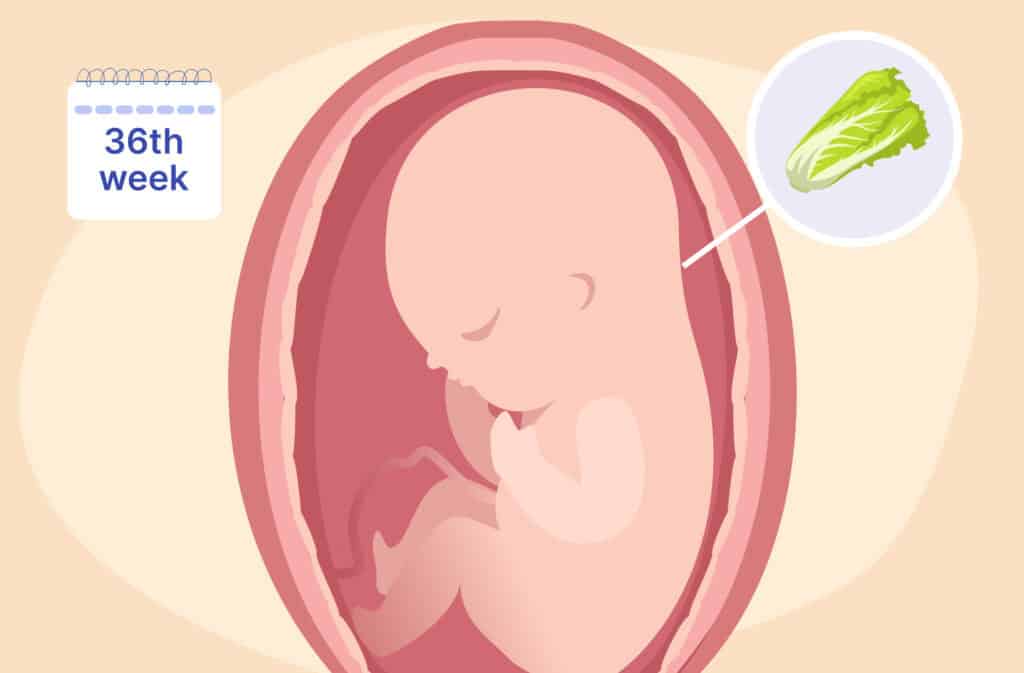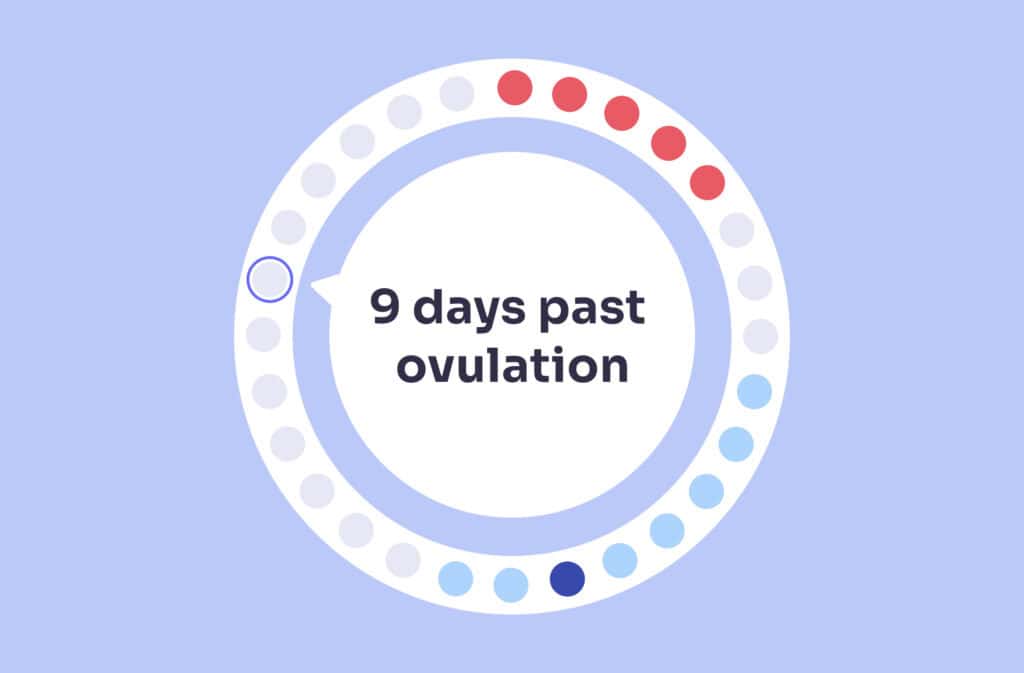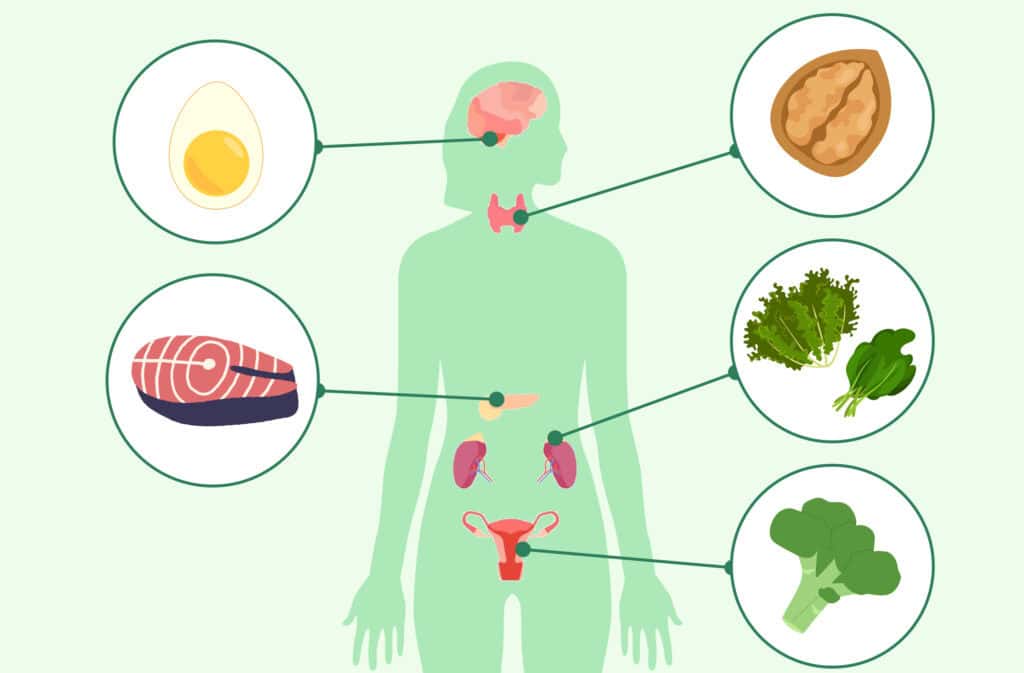Femia > Health Library > Pregnancy > Pregnancy week by week > 36 Weeks pregnant: Baby weight, discomfort relief, and delivery prep
36 Weeks pregnant: Baby weight, discomfort relief, and delivery prep

- Updated Feb 14, 2025
- Published
CRAFTED BY HUMAN
Crafted by human At Femia, we provide accurate and up-to-date information at every stage of your journey, from trying to conceive, pregnancy and postnatal support. All content is created by a real person based on in-depth research and own professional experience. Femia ensures that you will receive expert advice, strict accuracy and a personalized approach from our authors/medical experts. Learn more about our editorial policy.
FACT CHECKED
Fact checked At Femia Health, we maintain the highest standards of editorial excellence in delivering content focused on helping you conceive, guiding you through pregnancy, and supporting you postpartum. Explore our content review principles to learn how we ensure the accuracy and quality of our health and lifestyle tips for every stage of your journey.

Created with Hector Chapa, MD, FACOG, Clinical associate professor, Obstetrics and Gynecology Texas A&M University, College of Medicine in Bryan-College Station, USA
At 36 weeks pregnant, your baby is nearly early-term and preparing for birth. They are almost ready to meet the world, weighing around 2.6-2.7 kilograms and measuring about 18-19 inches long. Focus on managing symptoms, avoiding unnecessary risks, and getting ready for labor.
You’re now 36 weeks pregnant—just three week away from full term! At this stage, your body is preparing for labor, and you may experience symptoms like pelvic pain and period-like cramps and false labor pains. Let’s explore what’s happening with your baby, and your body, and how to navigate the final weeks before delivery.
Personalized meal plans, symptom tracking, and more with the Femia
Pregnancy symptoms at 36 weeks
Here are common symptoms you may experience at 36 weeks:
Cramping
Mild cramping is normal due to bloating, constipation, and round ligament pain. Braxton Hicks contractions may also cause cramping. However, if you experience regular contractions with lower back pain, more than six contractions an hour, or vaginal discharge or bleeding, contact your provider.
Headaches
Hormonal changes, dehydration, and sleep issues are common headache triggers during pregnancy. If headaches are severe, sudden, or accompanied by symptoms like fever or vision problems, it could signal preeclampsia, so consult your doctor.
Vaginal discharge
Changes in vaginal discharge may signal early labor. Loss of the mucus plug, which may be clear, pink, or bloody, can indicate labor is near. If you experience leaking amniotic fluid, contact your healthcare provider immediately.
Dizziness
Dizziness is common due to cardiovascular changes. Avoid standing up quickly, stay hydrated, and avoid overheating. If dizziness persists or worsens, consult your doctor.
Pelvic pain
Pelvic pain, often caused by relaxed ligaments and added pressure from the growing uterus, is common in the third trimester. Pregnancy bands and physical therapy may help relieve discomfort.
Your baby drops
As your baby drops into your pelvis, you may feel more pressure and discomfort in your lower abdomen. This can make walking difficult, but it can also ease shortness of breath and improve digestion. If you experience sharp pelvic pain, it’s called “lightning crotch.”
Braxton Hicks contractions vs true labor
| Aspect | Braxton Hicks Contractions | True Labor |
|---|---|---|
| Frequency | Irregular, not progressively closer together | Regular intervals, getting closer together |
| Intensity | Weak, often described as mild discomfort | Increases in strength over time |
| Duration | Short, usually lasting less than 30 seconds | Longer, lasting 30-70 seconds per contraction |
| Location of Pain | Felt mainly in the front of the abdomen | Starts in the back and radiates to the front |
| Effect of Movement | Stops or decreases with activity or a change in position | Continues regardless of movement or position changes |
| Cervical Changes | Does not cause dilation or thinning of the cervix | Causes the cervix to dilate and thin out (effacement) |
👉Find out more: Week 35 pregnancy: Symptoms, baby milestones, and delivery prep
36 Weeks pregnant symptoms not to ignore
Severe pelvic pain
Severe pelvic pain could indicate a complication such as preterm labor or a problem with the placenta. If the pain is sudden, intense, or accompanied by other symptoms like bleeding or contractions, seek medical attention immediately to rule out any serious issues.
Regular, painful contractions
Regular and painful contractions that increase in intensity could signal the start of labor, even if you’re not yet at your due date. If contractions occur at regular intervals, especially before 37 weeks, contact your healthcare provider, as they may indicate preterm labor.
Decreased baby movements
A noticeable reduction in your baby’s movements, particularly if they are usually active, requires immediate medical attention. A significant change in activity could be a sign of fetal distress or other complications, so contact your provider right away to ensure your baby’s well-being.
Severe swelling
Swelling in your face, hands, or around your eyes can be a sign of preeclampsia, a potentially serious pregnancy complication that can affect both you and your baby. If you experience sudden or severe swelling, especially accompanied by high blood pressure or headaches, seek immediate medical advice.
Watery vaginal discharge
If you experience a sudden gush or continuous leak of clear or watery discharge, it could indicate that your water has broken. This is a sign that labor may be imminent or that your baby is at risk of infection. Contact your healthcare provider immediately for evaluation and to monitor the situation.
Bleeding like a period
Any bleeding that resembles a period during pregnancy, especially in the third trimester, requires immediate evaluation. While some light bleeding may be normal, significant bleeding can indicate a placental issue, such as placental abruption, which could be life-threatening for both mother and baby. Contact your provider right away if you experience heavy bleeding.
Your body at 36 weeks pregnant
At 36 weeks pregnant, your body is making the final preparations for labor, and the physical changes are more noticeable. Your baby is likely moving lower into the pelvis, which can put additional pressure on your lower abdomen and pelvis, making movement feel more uncomfortable. Many women experience difficulty walking, sitting, or even standing due to this increased pressure. This is commonly referred to as “lightening,” as the baby drops lower into the birth canal in preparation for birth.
As your baby moves down, you may also feel a more frequent need to urinate due to pressure on your bladder. Some women also experience back pain or discomfort as their body adjusts to the growing weight and the baby’s position. These changes are all signs that your body is getting ready for the labor and delivery process, and although they can be uncomfortable, they are entirely normal during this stage of pregnancy.
36 Weeks in months
You’re about 9 months pregnant, with just four weeks (or less!) until your due date. A due date (as calculated from the first day of the last period) is 40 weeks. The end of pregnancy should be by 42 weeks.
36-Week pregnant belly
Your bump may feel heavier than ever, and you might notice your baby settling lower, a process called “lightening.” This can ease pressure on your lungs but increase discomfort in your pelvis.
Baby development at 36 weeks of pregnancy
At 36 weeks, your baby is in the final stretch of preparation for life outside the womb. While organs like the liver, kidneys, and lungs have been functioning for weeks, they are now fully developed and primed for life after birth. The brain is still growing rapidly, and your baby’s nervous system is becoming more refined, helping them coordinate vital functions like breathing and swallowing. These skills are essential for feeding and regulating body temperature once they’re born.
As your baby continues to accumulate fat, their body becomes rounder and more filled out. This fat will help them stay warm after birth, providing essential energy reserves for the early days of life. Their bones are hardening too, though the skull remains soft and flexible to aid in delivery. By the end of this week, your baby is almost ready for birth, but there’s still a little more fine-tuning before they’re fully prepared to meet the world.
Baby at 36 weeks:
- Weight: At this stage, your baby weighs between 2.6-2.7 kilograms (5.7-6 pounds). This weight gain is essential for building up fat stores that will help keep your baby warm after birth.
- Length: Your baby measures approximately 18-19 inches long, roughly the size of a head of romaine lettuce.
- Movements: As space in the uterus becomes more cramped, your baby’s movements will start to feel less pronounced, with fewer sharp kicks or rolls. However, their movements may be slower, more deliberate, and they may still make stretches, rolls, or shifts. You should still feel movements, though they might feel different now due to limited space.
- Additional development: The digestive system is fully matured and ready to process food, and your baby may even be practicing “breathing” by moving amniotic fluid in and out of their lungs, helping them strengthen their chest muscles. The final layers of fat are helping them to become rounder, and their immune system is getting stronger by being exposed to your antibodies.
At this stage, many babies are in the head-down position in preparation for birth. However, there is still some time for your baby to shift into this position if they are not already in place.
36-Week ultrasound
A 36-week ultrasound may be performed to check your baby’s position, amniotic fluid levels, and overall growth. This is also a good time to confirm whether your baby is head-down for delivery.
36-Week preemie: what to expect
A baby born at 36 weeks is considered late preterm but is often healthy with minimal medical intervention.
Development and care:
- Lungs: Although lungs are fully developed, they may not have full function until 39 weeks, though breathing support may occasionally be needed.
- Feeding: Some preemies may require assistance until feeding reflexes mature.
- NICU stay: Babies born at 36 weeks typically require shorter NICU stays compared to earlier preemies.
Most babies born at 36 weeks catch up developmentally with their full-term peers by their first birthday.
Tests to expect at 36 weeks pregnant
Your healthcare provider will focus on monitoring your health and your baby’s readiness for delivery:
- Blood pressure check: Screens for preeclampsia or hypertension.
- Urine test: Detects protein.
- Fetal heartbeat and movements: Monitors your baby’s activity and heart rate.
- Group B strep (GBS) test: Ensures you’ll receive antibiotics during labor if needed. It is routine to collect a vaginal and rectal swab test for GBS from 36 weeks until 37 weeks 6 days. This is not an STI but part of the normal bacteria in some women.
- Fundal height measurement: Assesses your uterus’s growth and the baby’s position.
- TDAP vaccine. 36 weeks is typically the last opportunity to receive the TDAP vaccine if not done. TDAP is given every pregnancy between 27 and 36 weeks pregnancy.
Personalized meal plans, symptom tracking, and more with the Femia
Things to avoid at 36 weeks pregnant
- Stressful activities: Practice relaxation techniques to stay calm and reduce anxiety.
- Standing for long periods: Take breaks to rest and elevate your feet to reduce swelling.
- Heavy lifting: Avoid activities that strain your back or abdomen.
- Unpasteurized foods: Continue avoiding raw or unpasteurized foods to reduce the risk of infection.
👉Find out more:
37 Weeks pregnant: Labor signs, baby development, and discomfort relief
36 weeks pregnant: Symptoms of labor
As you near the final stages of pregnancy, you might start noticing signs that your body is preparing for labor. While not all of these symptoms necessarily mean labor is imminent, they can be a sign that your body is getting ready. Here are some common symptoms of labor at 36 weeks:
- Braxton Hicks contractions: These contractions are usually irregular and can feel like a tightening of your belly. Unlike true labor contractions, they don’t get stronger over time and typically go away with rest or hydration.
- Lightening: Lightening refers to when your baby drops lower into your pelvis, typically occurring a few weeks before labor begins. This can result in more pelvic pressure and discomfort, but may also relieve some of the pressure on your diaphragm, allowing you to breathe more easily.
- Increased vaginal discharge: As labor approaches, you may notice an increase in vaginal discharge. This could include the loss of your mucus plug, which may appear as thick, clear, pink, or slightly bloody mucus. This is a sign that your cervix is beginning to soften and prepare for delivery.
- Bloody show: The bloody show is another sign that labor may be near. It’s a small amount of blood mixed with mucus that is often seen after the mucus plug comes out. It’s a normal part of labor preparation, but if you notice a significant amount of bleeding, it’s important to contact your doctor.
- Water breaking: If your amniotic sac ruptures, it’s known as your water breaking. This can happen as a gush of fluid or as a slow leak. If this happens, you should contact your healthcare provider immediately, as it’s a sign that labor could begin soon.
- Lower back pain: As your baby moves into position, you may experience more lower back pain. This can be a dull ache or sharp pain, especially if you’re having contractions. Some women experience persistent back pain, especially if the baby is in a posterior position (facing your abdomen).
- Nesting instinct: Some women experience a burst of energy and an urge to prepare everything for their baby’s arrival. This is often referred to as the “nesting instinct” and is a natural part of preparing for labor.
If you’re experiencing any of these symptoms, it’s important to stay in touch with your healthcare provider. They can help you determine if labor is imminent and guide you on what to do next.
Health tips and self-care at 36 weeks pregnant
At 36 weeks pregnant, your body is nearing the final stages of pregnancy, and self-care becomes increasingly important to ensure your comfort and well-being. Here are some actionable tips to help you navigate the final weeks of your pregnancy.
Stay hydrated
Drinking plenty of water is essential at 36 weeks pregnant. Staying hydrated helps with fluid retention and prevents dehydration, which can cause swelling and fatigue. Aim to drink at least 8-12 glasses of water daily, especially if you’re experiencing swelling or constipation.
Prepare for labor
It’s a great time to familiarize yourself with labor signs and breathing techniques. Practicing deep breathing or relaxation exercises can help alleviate stress and prepare your body for the demands of labor. You might also want to revisit your birth plan and talk with your partner about the delivery process.
Get enough rest
Though it can be harder to get comfortable at night, try to rest as much as possible. Your body needs extra energy as it prepares for labor. Use pillows to support your back, belly, and between your legs to create a more comfortable sleeping position.
Manage pelvic pressure
As your baby drops into the pelvis, you may feel increased pelvic pressure. This is normal, but it can cause discomfort. To alleviate pressure, try to rest frequently, use a pregnancy pillow for support, and practice pelvic tilts or other gentle exercises to relieve tension.
Talk to your midwife
It’s essential to maintain open communication with your midwife or healthcare provider during this stage. Talk to them about any discomforts you’re experiencing, such as swelling, back pain, or sleep troubles. They can provide personalized advice and make sure everything is progressing as expected. If you notice any sudden or severe symptoms, such as excessive swelling, vision changes, or headaches, consult your midwife immediately.
Keep track of baby movements
Tracking your baby’s movements can give you valuable insight into their health. Although routine kick counting is no longer recommended by the American College of Obstetricians and Gynecologists (ACOG) for fetal monitoring, if you notice a reduction in activity or a significant change in your baby’s usual pattern, reach out to your healthcare provider immediately.
Avoid heavy lifting and strenuous activity
At 36 weeks pregnant, your body is working harder than ever. To prevent unnecessary strain, avoid lifting heavy objects or engaging in activities that require prolonged standing or exertion. Focus on light activities that keep you comfortable and well-rested.
Taking care of your body and keeping in touch with your healthcare provider will help ensure you’re as prepared and comfortable as possible as you approach labor.
Questions from the Femia community
How to deal with physical discomfort during sex?
Physical discomfort during sex in late pregnancy is common due to your growing belly and sensitive pelvic area. Try comfortable positions like side-lying or sitting to reduce pressure on your abdomen. Communicate openly with your partner and stop if you feel pain or discomfort. Always consult your provider if you have concerns about sexual activity at this stage.
How to make labor easier?
Start by practicing breathing techniques to stay calm during contractions. For some, aromatherapy helps with labor discomforts. Staying physically active with gentle exercises can improve stamina and flexibility. Packing comforting items, like music or a favorite pillow, can create a soothing environment. Discuss pain relief options, such as epidurals or natural methods, with your provider to feel prepared.
Is it normal to have cramps at 36 weeks pregnant?
Yes, mild cramps at 36 weeks pregnant can be normal due to the growing pressure on your uterus, changes in hormones, or Braxton Hicks contractions. However, if the cramps are severe or accompanied by other symptoms like bleeding, contact your healthcare provider immediately.
The bottom line
At 36 weeks pregnant, your baby is nearly early-term and preparing for birth. Your healthcare provider will focus on monitoring your health and your baby’s readiness for delivery/ Monitor symptoms closely, focus on self-care, and finalize your labor plans to ensure a smooth transition into delivery.
References
- “36 Weeks Pregnant: Symptoms, Baby Development & Tips.” BabyCenter, www.babycenter.com/pregnancy/week-by-week/36-weeks-pregnant.
- “Week 36 of Pregnancy: Symptoms, Baby Development & More.” What to Expect, www.whattoexpect.com/pregnancy/week-by-week/week-36.aspx.
- “36 Weeks Pregnant: Baby Development, Symptoms & Tips.” NHS, www.nhs.uk/pregnancy/week-by-week/1-to-12/36-weeks/.
- “Pregnancy Week 36: What to Expect.” American Pregnancy Association, www.americanpregnancy.org/healthy-pregnancy/week-by-week/36-weeks-pregnant/.

Learn about potential symptoms at 9 days past ovulation (9 DPO) and when pregnancy tests can begin to detect hCG levels for accurate results. Expert advice from Femia.

Discover natural strategies, tips, and medical guidance on how to balance your hormones in a week with diet, lifestyle, self-care tips, and supplements.

Learn the difference between normal and abnormal baby head shapes, when to worry about flat head syndrome, and how to address it effectively.
